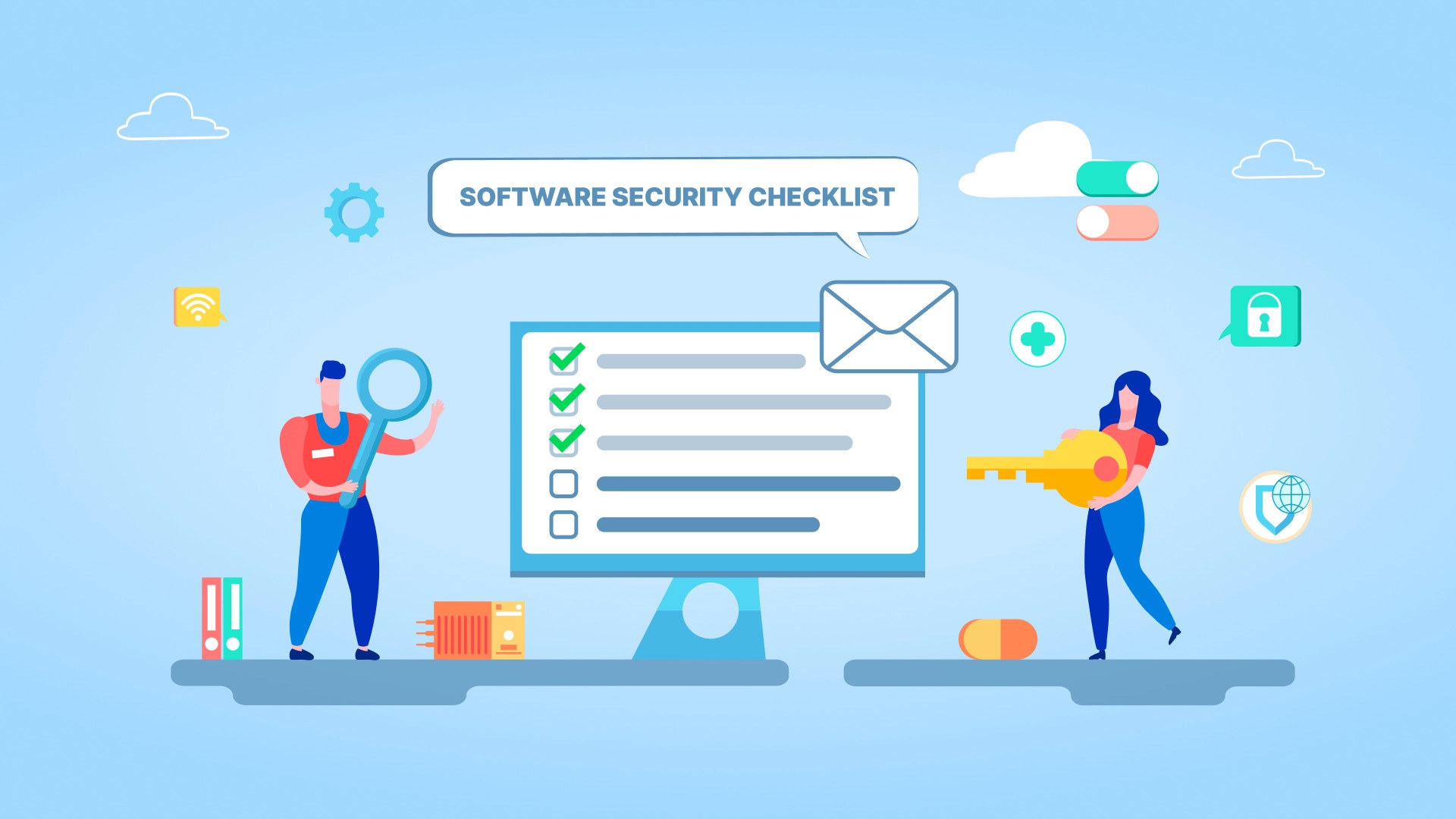

Software Security Audit: How to Be Sure Your Company Is Secured?
In everyday life, each of us often uses one or another checklist to ensure that we are following the direction of achieving a particular goal. For example, before going to the store, we write lists so we don’t forget anything. When surrounded by shelves filled with products with colorful labels, it is easy to lose track of the item we need. We check before leaving the store by comparing our list to what’s in the cart. “Did I get everything I needed? Do I require to move anything to next week’s list?”.
Software security audits are a preventative measure, as is a product listing review. They establish standards against which organizations are tested to ensure that they comply with internal security policies and external limitations.
A software security audit is a comprehensive assessment that examines protections across digital applications, networks, and employees to determine whether security policies are being followed and identifies areas for improvement. It includes susceptibility scanning to identify security holes in IT systems or penetration tests to achieve unauthorized access to systems, applications, and websites. Finally, the penetration test reports generated after all the necessary procedures are completed are sent to the organization for further analysis and action.
Why Software Security Is So Important?
In our interconnected world, security is a constant concern. The more complex the IT environment, the more vulnerabilities there may be. Software security audits combat this trend by serving as an obligation to cross-check systems for risks.
Examining a company’s security posture, these audits identify gaps in existing security measures, processes where employee training can be improved, and opportunities to create new security policies. They serve as a litmus test for the effectiveness of existing strategies and highlight new areas of focus for the security team.
The audit process is also essential to ensure good visibility into different areas of the organization. An audit provides organizational accountability like a grocery list verifies that you have found everything you need.
Event-Based Audits
A software security audit is integral to a company’s long-term data protection strategy. It means that audits should be conducted at least once a year, but more often are recommended to adjust safety practices more quickly. Cybersecurity best practices evolve as technology evolves, and frequent audits will ensure your organization stays abreast.
In addition to regular audits, experts recommend that organizations conduct security audits after an attack or major update. Both scenarios are considered as actual events.
In an attack, such as a data breach, the audit will be focused on verifying that the applied solution is effective for that security breach. Naturally, your team will also emphasize fixes to prevent another violation.
After a major upgrade, such as installing a new tool, replacing a framework, or moving data, your environment will have changed significantly since the last audit. In this case, the check safeguards against new vulnerabilities that might have been introduced due to a significant change.
However, given the time and resources required for a complete security audit, it is vital to determine the impact level of the update that triggers the audit. This prioritization ensures that you allocate security team resources wisely.
Types of Security Audits
There is more than one way to classify a software security audit. As a rule, it is classified based on approach, methodology, etc. Some of the standard classifications are:
Based on the Approach
Black Box Audit: the auditor only knows publicly available information about the organization to be audited.
Gray Box Audit: the auditor is given some information to start the audit process. The auditors can also collect this information, but it is provided to save time.
White Box Audit: in this type of security audit, the auditor is provided with detailed information (i.e., source code, employee access, etc.) about the organization to be audited.
Based on the Methodology
Penetration Tests: an auditor attempts to penetrate the organization’s infrastructure.
Compliance Audits: only specific parameters are checked to see if the organization meets security standards.
Risk Assessment: analysis of critical resources that may be at risk to a security breach.
Vulnerability Tests: the necessary scans are performed to detect possible security threats. There can be many false positives.
Due Diligence Surveys: usually used to analyze existing security standards within an organization.
Additional Security Assessments
As outlined below, it is also essential to distinguish between other security measures your organization may perform.
Cyber Security Audits
Cyber security audit software is a subset of security audits that focus specifically on information systems within an organization. Given the digital environment in which most companies operate, they are synonymous with security audits. However, focusing only on cyber security would be an oversight.
For example, your IT environment may be secure. Still, suppose someone can walk through the front door of your office and gain access to a computer with administrative privileges. In that case, this is a critical vulnerability that needs to be addressed.

Cyber Security Audit Checklist
The cyber security audit checklist will mirror the security audit checklist discussed in the next section. However, it will focus more on digital security practices, so we’ve included an index below to help you track these differences:
Define the objectives and evaluation criteria.
List potential threats.
Evaluate staff training on digital security.
Accurately identify the risks in your virtual environment.
Explore business practices versus security policies.
Evaluate your data security strategy.
Review active monitoring and testing approaches.
Update security practices based on findings.
Vulnerability Assessment
A vulnerability assessment examines the software and IT environment to determine whether existing security policies are working correctly. For example, a user without administrative access should not be able to run the company's HR program and delete another user. The vulnerability assessment will try to perform this unauthorized action to see if the user is blocked from initiating this action or how far they can progress if not.
Penetration Testing
Penetration testing focuses on the different ways attackers can try to gain access to internal systems. Security teams often conduct these tests as if they were terrible actors, starting outside and working their way into the organization’s network. Penetration testing proves that existing tools and procedures provide adequate protection and identify gaps that the security team needs to close.
Vulnerability assessment and penetration testing can be performed as part of network security audit software. Still, your security team will also perform these assessments to explore additional risks identified during the audit or as separate tests, so it’s essential to understand the differences.
Security Audit Checklist
Now that you understand security audits and why they are essential, let’s go through a checklist of different areas.
Define Your Goals
Objective titles will help your team identify the results you want to achieve through the audit. The objectives also establish benchmarks for measuring the current state of security.
List Potential Threats
Depending on your industry, the threats to your organization may vary. Identifying the most relevant threats to your organization makes sense so you can fine-tune your defenses and stop them.
This activity will also help your audit team define the scope of your audit and better look for vulnerabilities in later stages.
Evaluate Employee Training
Employees are another part of your defense, and many cyberattacks target them through phishing and social engineering. It means adequate security training is critical to teaching employees how to recognize and respond to threats.
If there is any gap in your employee’s knowledge or compliance, you must address the gap through refresher training or new courses at the end of the term.
Accurate Identification of Risks in Your Environment
Your audit team will take a deep dive into your digital work environment. Are all systems up to date with the latest patches? Are there unknown devices or unauthorized applications on the network? These results will be your strategy in the next phase.
Update Your Security Practices
Now that you completely understand your organization’s security practices, implement solutions to address the risks you’ve identified. These fixes should be prioritized based on the impact on employee workflows, the severity of the vulnerability, and the resources required.
For example, a low-impact change like regular password updates won’t require entirely new tools or a major system overhaul. It can prevent attackers from moving between systems if they’ve cracked a single employee’s password.
Final Word
The extent and frequency of your audits will depend on what makes sense for your organization. For example, if you have a small group, frequent auditing may be unnecessary until you can add additional staff or tools to automate processes.
The most crucial factor in a security audit is its regularity. Any audit strategy will pay dividends by providing a better picture of your organization’s security posture and where to focus your efforts to strengthen your defenses.
The safest way is to develop software with an initial focus on security. BeKey specializes in this approach, we have our own method of security development, which includes:
- risk analysis at the design stage;
- compliance with OWASP/HIPAA/GDPR standards;
- secured development process;
- static and dynamic code analysis;
- internal pentesting;
- DRP;
- training and coaching our development teams.
Have any questions or suggestions? Feel free to talk to us anytime!
Tell us about your project
Fill out the form or contact us

Tell us about your project
Thank you
Your submission is received and we will contact you soon
Follow us

